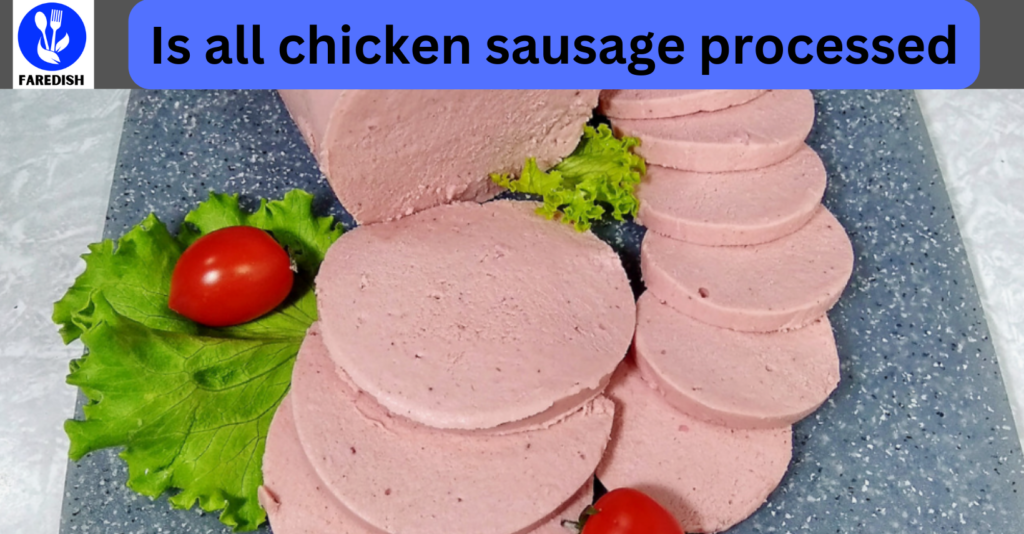Understanding Chicken Sausage Processing
Chicken sausage processing refers to the various methods involved in transforming raw chicken meat into sausage. This process typically includes grinding the chicken meat and mixing it with seasonings, additives, and preservatives. The mixture is then stuffed into casings, such as cellulose or collagen, or formed into patties. Here, you willfind the answer of Is all chicken sausage processed?.
By processing chicken sausage, manufacturers enhance its flavor, texture, and shelf life. However, it is important to note that not all chicken sausages undergo the same level of processing. Some sausages may contain additional additives and preservatives, while others may be minimally processed with only natural ingredients. It is essential to read the product labels and ingredients list to determine the level of processing involved.
Understanding the processing methods used in chicken sausage production allows consumers to make informed choices about the products they purchase. By considering factors such as additives, preservatives, and natural ingredients, individuals can select chicken sausages that align with their personal preferences and dietary needs.
What qualifies as processed chicken sausage
Processed chicken sausage is typically defined as sausage that has undergone various methods of transformation from raw chicken meat to its final form. These methods may include grinding the chicken meat, mixing it with seasonings, additives, and preservatives, and stuffing it into casings or forming it into patties. The level of processing can vary depending on the specific brand and variety of chicken sausage.
In general, processed chicken sausage often contains additional ingredients such as fillers, binders, flavorings, and preservatives to enhance its flavor, texture, and shelf life. These additives can include things like sodium nitrite, MSG, and artificial colors or flavors. However, not all processed chicken sausages are created equal. Some may be minimally processed with only natural ingredients, while others may have a higher degree of processing and contain more additives.
It is important for consumers to read product labels and ingredients lists to determine the level of processing involved in the chicken sausage they are considering. This information can help individuals make informed choices and select products that align with their personal preferences and dietary needs.
Different processing methods of chicken sausage
Manufacturers use different processing methods to turn raw chicken meat into sausage. Grinding the chicken meat to a specific consistency is a common method. This process evenly distributes fat, seasoning, and other ingredients throughout the sausage. Then, workers mix the ground meat with seasonings, additives, and preservatives to improve flavor and texture.
Another method involves casing, in which workers stuff the mixture into casings made from natural or synthetic materials. This step gives the sausage its unique shape and allows for individual servings. Alternatively, they can shape the mixture into patties or other forms without using casings.
Next, the sausage typically undergoes a cooking process, such as baking, smoking, or grilling, to ensure it is thoroughly cooked and safe for consumption. Finally, manufacturers package the sausages and may perform additional processing steps, like pasteurization or freezing, to prolong shelf life.
Different brands and varieties of chicken sausage might use varied processing methods, leading to differences in flavor, texture, and appearance. Consumers should read product labels carefully and select sausages that meet their taste preferences and dietary requirements.
Health Considerations
Nutritional aspects of processed chicken sausage can vary depending on the specific brand and ingredients used. It’s essential to carefully read the nutrition label to understand the levels of fat, sodium, and additives present in the sausage. Processed chicken sausage may also contain higher amounts of preservatives, such as nitrates, which have been linked to certain health concerns when consumed in excess.
The processing of chicken sausage can impact its overall health benefits. While chicken sausage can be a good source of protein, the addition of unhealthy fats and sodium during processing can diminish its nutritional value. Additionally, the cooking methods used, such as frying, can further increase the calorie and fat content of the sausage.
Individuals following specific dietary guidelines, such as low-sodium or low-fat diets, need to exercise caution when considering the consumption of processed chicken sausage. Consulting a healthcare professional or nutritionist is always advisable to ensure that processed chicken sausage fits into your particular health objectives.
Nutritional aspects of processed chicken sausage
Processed chicken sausage can vary in its nutritional composition depending on the brand and ingredients used. It is important to carefully read the nutrition label to understand the levels of fat, sodium, and additives present in the sausage. While chicken sausage can be a good source of protein, the processing can often add unhealthy fats and sodium, which can diminish its nutritional value. The cooking methods used, such as frying, can further increase the calorie and fat content of the sausage. It is advisable for individuals with specific dietary needs, such as those following a low-sodium or low-fat diet, to be cautious when consuming processed chicken sausage. Consulting with a healthcare professional or nutritionist can help determine if processed chicken sausage aligns with specific health goals.
Impact of processing on health benefits of chicken sausage
The processing of chicken sausage can have a significant impact on its health benefits. While chicken sausage can be a good source of protein, the processing methods used can alter its nutritional profile. Many processed chicken sausages contain added sugars, unhealthy fats, and high levels of sodium. These additives can diminish the health benefits of the sausage and contribute to negative health outcomes such as high blood pressure and obesity. Additionally, certain processing methods, such as smoking or curing, can result in the formation of potentially harmful substances like nitrosamines. It is important for individuals to be mindful of the processing techniques used in the chicken sausage they consume and to opt for options with minimal additives. Incorporating unprocessed chicken sausage or making homemade sausage using lean chicken and natural seasonings can help maximize the health benefits of this protein source.

Popular Brands and Varieties
When it comes to processed chicken sausages, there are a variety of popular brands to choose from. These brands offer different flavors and options to cater to various tastes and dietary preferences. One popular brand is Aidells, known for their gourmet chicken sausages made with natural ingredients and unique flavor combinations such as Spicy Mango with Jalapeno and Pineapple. Another well-known brand is Applegate, which offers organic chicken sausages made without artificial ingredients or preservatives. They have options like Chicken and Sage or Spinach and Feta. Hillshire Farm is also a popular choice, offering a range of flavors including Smoked Sausage and Italian Style Chicken Sausage. For those looking for a healthier option, Al Fresco offers chicken sausages that are lower in fat and calories. With these various brands and flavor profiles, consumers can find the processed chicken sausages that suit their taste preferences and dietary needs.
Overview of top processed chicken sausage brands
When it comes to processed chicken sausages, there are several top brands that have become favorites among consumers. Aidells is known for its gourmet chicken sausages made with natural ingredients and unique flavor combinations. Applegate offers organic chicken sausages without artificial ingredients or preservatives, providing a healthier option. Hillshire Farm is a popular choice with a range of flavors, including smoked sausage and Italian style chicken sausage. Al Fresco caters to health-conscious individuals, offering lower fat and calorie options. These brands prioritize taste, quality, and variety, ensuring there is something for everyone. With their flavorful offerings, these top processed chicken sausage brands have gained a strong following and continue to be a go-to choice for those seeking convenient and delicious meal options.
Varieties of processed chicken sausage available in the market
There is a wide variety of processed chicken sausages available in the market to cater to different tastes and preferences. These sausages come in various flavors and ingredient combinations, adding diversity to your meals. Some popular varieties include:
- Smoked Chicken Sausage: This type of sausage is known for its rich, smoky flavor, which adds a delicious twist to your dishes.
- Italian Style Chicken Sausage: Inspired by traditional Italian flavors, this sausage is seasoned with herbs and spices like oregano, garlic, and fennel, creating a savory and aromatic taste.
- Spicy Chicken Sausage: For those who enjoy a bit of heat, spicy chicken sausages are a fiery option, typically made with chili peppers or other hot spices.
- Apple and Maple Chicken Sausage: The sweet and savory combination of apple and maple flavors adds a unique twist to chicken sausage, perfect for breakfast or a sweet-savory dinner option.
These are just a few examples of the varieties available in the market. With a multitude of flavors and ingredient combinations, there is a processed chicken sausage to suit every palate and culinary preference.
Cooking and Preparation Tips
To ensure the best results when cooking processed chicken sausage, there are a few tips and tricks to keep in mind.
First, it is important to fully cook the sausage to a safe internal temperature of 165°F (74°C) to eliminate any potential bacteria. This can be achieved by grilling, pan-frying, or baking the sausages until they are browned and cooked through.
When preparing the sausage, it is recommended to prick the casings with a fork before cooking. This allows the excess fat to escape and prevents the sausages from bursting.
For added flavor, consider marinating the sausages in a mixture of your favorite herbs, spices, and oils before cooking. This will infuse the sausages with delicious flavors and enhance their taste.
To maintain moisture, it is advisable to cook the sausages over medium heat and avoid overcooking, as this can lead to dryness.
Lastly, when serving the cooked sausages, consider pairing them with complementary sides or incorporating them into various recipes, such as pasta dishes, stir-fries, or stuffing.
By following these cooking and preparation tips, you can enjoy flavorful and perfectly cooked processed chicken sausages.
Best practices for cooking processed chicken sausage
When cooking processed chicken sausage, ensure it reaches a safe internal temperature of 165°F (74°C) to eliminate harmful bacteria. This can be done by grilling, pan-frying, or baking until browned. Pricking the casings before cooking helps release excess fat and prevents bursting. Marinating in herbs, spices, and oils can boost flavor. Cook on medium heat to retain moisture and avoid dryness. Serve with complementary sides or within recipes to enhance taste. Following these practices ensures delicious and safely cooked chicken sausages.
Creative recipes using processed chicken sausage
When it comes to incorporating processed chicken sausage into your meals, there are endless possibilities for creative and delicious recipes. Here are a few ideas to inspire you:
- Chicken Sausage and Vegetable Skewers: Thread chunks of chicken sausage, bell peppers, onions, and zucchini onto skewers. Grill them for a flavorful and colorful meal.
- Chicken Sausage Fried Rice: Chop up the sausage and sauté it with cooked rice, peas, carrots, and scrambled eggs. Season with soy sauce for a quick and satisfying meal.
- Chicken Sausage Pasta: Slice the sausage into bite-sized pieces and toss it with your favorite pasta, marinara sauce, and vegetables. Top with cheese for a comforting pasta dish.
- Chicken Sausage Breakfast Casserole: Combine diced chicken sausage, eggs, cheese, and vegetables in a baking dish. Bake until golden and bubbly for a hearty breakfast or brunch option.
- Chicken Sausage and Spinach Stuffed Portobello Mushrooms: Remove the stems from large portobello mushrooms and fill them with a mixture of cooked chicken sausage, spinach, garlic, and cheese. Bake until the mushrooms are tender and the filling is melted and golden.
These creative recipes will help you elevate your meals and make the most of processed chicken sausage. Experiment with flavors and ingredients to find your favorite combination.
Unprocessed Alternatives
When it comes to choosing unprocessed alternatives to chicken sausage, there are a few options to consider. One popular choice is to make your own homemade chicken sausage using fresh, ground chicken and a blend of herbs and spices. This allows you to control the ingredients and ensure a higher quality product. Another option is to look for specialty stores or butcher shops that offer fresh, handcrafted chicken sausage that thet made it using traditional methods and minimal processing. These alternatives often have a more authentic taste and texture compared to processed chicken sausages. Additionally, some stores offer organic or pasture-raised chicken sausages that are free from antibiotics and hormones. While unprocessed alternatives may require a bit more effort to find or prepare, they can offer a healthier and more natural option for those looking to avoid processed foods in their diet.
Exploring unprocessed chicken sausage options
For those seeking healthier alternatives to processed chicken sausage, making homemade chicken sausage with fresh, ground chicken and your choice of herbs and spices is a great option. This approach gives you complete control over ingredients, ensuring a high-quality, healthier product. Alternatively, specialty stores and butcher shops may offer fresh, handcrafted chicken sausages with minimal processing, delivering a more authentic taste and texture. Some may also carry organic or pasture-raised options, free from antibiotics and hormones. Though finding or preparing these alternatives might require extra effort, they provide a more natural and nutritious choice for those aiming to avoid processed foods, allowing for a tasty yet balanced diet within a concise setup.
Benefits of choosing unprocessed chicken sausage
Choosing unprocessed chicken sausage offers several benefits. Firstly, unprocessed sausages tend to have a more authentic taste and texture compared to their processed counterparts. suasages often made with fresh, high-quality ingredients, allowing the natural flavors to shine through. Additionally, unprocessed chicken sausages generally have a shorter ingredient list, without the added preservatives, fillers, and artificial flavors commonly found in processed sausages.
Furthermore, unprocessed chicken sausages are typically made using traditional methods, which can result in a higher nutritional value. They are often lower in sodium and have a higher protein content compared to processed options. Unprocessed sausages also allow for more customization, as you have the freedom to choose the specific blend of herbs, spices, and seasonings to suit your taste preferences.
By choosing unprocessed chicken sausage, individuals can enjoy the delicious flavors of sausage while still maintaining a wholesome, balanced diet.
Conclusion
In conclusion, be mindful of processing methods affecting chicken sausage’s nutrition and health benefits. Processed versions may contain harmful additives and high sodium. Always read labels and choose sausages with fewer additives and less sodium.
Alternatively, individuals can explore the option of unprocessed chicken sausage, which offers several benefits. Unprocessed sausages tend to have a more authentic taste, shorter ingredient list, and higher nutritional value. They can be a healthier alternative, providing a protein-rich and flavorful addition to a balanced diet. By choosing unprocessed chicken sausage, individuals can enjoy the best of both worlds – delicious flavors and wholesome ingredients. So, next time you’re craving chicken sausage, consider opting for the unprocessed variety for a more natural and nutritious choice.
Summary of processed vs. unprocessed chicken sausage
Processed chicken sausage people can make it using various methods such as smoking, curing, and adding preservatives. It often contains additives, fillers, and high levels of sodium, which can be detrimental to overall health. Nutritional aspects of processed chicken sausage may vary depending on the specific brand and ingredients used.
On the other hand, unprocessed chicken sausage offers a more natural and wholesome option. It tends to have a shorter ingredient list and higher nutritional value. Unprocessed sausages can be a healthier alternative, providing a protein-rich and flavorful addition to a balanced diet.
Processed chicken sausage is convenient but not as healthy as unprocessed varieties. It’s vital to choose sausages with fewer additives and less sodium for a natural taste.
Final thoughts on chicken sausage in a diet
Chicken sausage adds protein to meals, but choose wisely. Processed variants often contain unhealthy additives and high sodium. Unprocessed chicken sausage, however, offers a healthier, more natural option with fewer additives. Balance and moderation are key in a diet. Opt for minimal additives and low sodium to enjoy chicken sausage healthily.
Here are more. click here
see what people say on Quora


